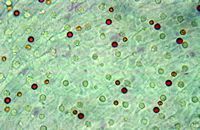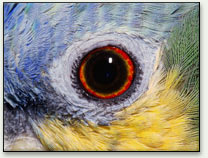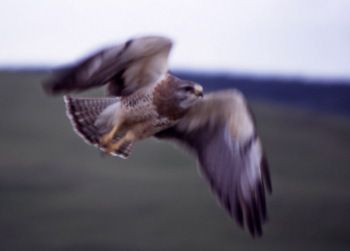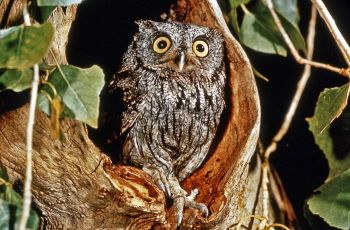A page from the "Causes of Color" exhibit...
What colors do birds see? (speculation)

Birds have an elaborate variety of cones cells, with more morphological complexity and diversity than those of mammals.
Four types of photo-pigment have been identified in the European starling; these have peak sensitivities over a much broader range than those of humans.
Birds, with their mastery of the air, have always held a fascination for humankind. While we have been able to approximate their soaring journeys with our relatively rudimentary airplanes, our understanding of their keen vision and related behaviors is still in its infancy.
As with all animals, studying color perception in birds is challenging. From observation, it’s clear that different species are attracted to bird feeders of particular colors, and that changing the color of ambient light can trigger early breeding, or alter fertility rates, by mimicking the change of seasons.
Only recently have we begun to grasp that vertebrates such as birds and fish possess more sophisticated color visual systems than we do. While we are trichromats, having photo-pigments with sensitivities at three peak wavelengths, birds have photo-pigments with sensitivities at four or five peak wavelengths, making them true tetrachromats, or perhaps even pentachromats. In some species, the visual spectrum extends into the ultraviolet range, once thought to be visible only to insects.
It is as hard for us to imagine how birds perceive color as it is for a colorblind person to imagine full color vision; it is outside of our experience. This impacts the study of bird behavior, and our grasp of how birds navigate during migration, classify objects, and interact socially and sexually. For example, some species we see as having identical male and female plumage differ when seen in the ultraviolet range - a difference apparent to the birds themselves.

Oil droplets from a European starling. The purpose of the oil droplets is unknown. They may act as cut-off filters, filtering out high-energy lower wavelengths with their potentially harmful effects, or they may enhance visual contrast.
Mechanics of color vision in birds
Some birds’ eyes have a far higher proportion of cones to rods than human eyes, and their cones are complex. The inner segment contains a colored oil droplet beside the base of the outer segment, which filters light before it can reach the visual pigment. The oil droplets are either clear or are colored by a variety of carotenoids.
In addition to single cones, there are also double cones, consisting of two closely contiguous cells known as the principal and accessory members of the pair. These double cones have also been observed in fish, amphibians, and reptiles. The photoreceptors in the two members may differ. Again, their role is not fully understood, but it seems as though some of the color processing performed in human brains may begin within the photoreceptors themselves in other vertebrates.
The structure of the bird retina is also more complex than the human retina. The fovea, where there is a localized high concentration of cones, may form a lateral stripe instead of a central area. Some birds possess two or more foveae. The fovea is deeper than ours, creating a larger surface area to accommodate a higher number of cones.
Another specialization is suggested by the non-uniform distributions of different colored oil droplets (such as the red quadrant found in the pigeon’s retina). This indicates a degree of complexity that is not present in the human eye. Our sensory experience does not provide a framework for intuitively understanding the role of these specializations.
Raptors, like this Swainson’s hawk, have the most acute avian vision, relying on sight to spot and capture prey from altitude. Hawks and eagles have five times as many cones as humans. An eagle has a larger retina than a human. While most birds have laterally positioned eyes, giving them a broader field of view, raptors have eyes set frontally to give them increased binocular vision and depth perception.
Diurnal birds tend to have increased ultraviolet sensitivity, with far more cones than rods, while nocturnal species such as owls tend towards sensitivity in the infrared end of the spectrum and have a relatively high proportion of rods.
Why do birds need color vision?
There is a strong correspondence between the habitat and behavior patterns of different species, and their spectral sensitivities.
All flying birds operate in the environment of the sky, and rely on a comprehensive visual perception in three-dimensional space. Birds that live on seeds and fruits in the forest canopy need to differentiate between green and the colors of their chosen foods. Aquatic birds live in an environment where different colors predominate, and some are able to control their focus underwater.
One possible advantage of ultraviolet vision is in spotting the traces left by prey. The urine and feces of mice are visible in the ultraviolet range, so they stand out against the uniform color of a cultivated field to the eyes of a hunting kestrel.
Open questions
Many mysteries remain regarding birds and their senses. Many birds migrate annually over great distances, and researchers are trying to determine what triggers these migrations and how birds navigate. Birds may be able to detect the polarization of light to calculate the position of the sun in the sky, or they may have some means of detecting the earth’s magnetic field, giving them built-in compasses.
Migrating birds that fly at night need different navigational equipment. When compared to daytime flyers, songbirds that migrate nocturnally have an enlarged section of the brain, which apparently controls this aspect of migration.
The future holds great promise as our understanding of avian vision expands. We will be able to gain new insights into the evolution, physiology, and behavior of birds, and into the way they interact with their environment.







